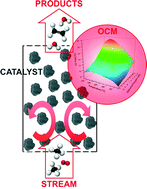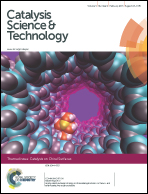Feasibility study of the Mn–Na2WO4/SiO2 catalytic system for the oxidative coupling of methane in a fluidized-bed reactor
Abstract
The catalytic system Mn–Na2WO4/SiO2, known for its relatively stable performance for oxidative coupling of methane (OCM), has been thoroughly investigated in the past. In order to evaluate its catalytic performance, micro-fixed-bed reactors were used almost exclusively. This study aims to answer the question of whether this catalytic system would be applicable on a larger scale using a miniplant fluidized-bed quartz glass reactor. Special consideration was given for finding the optimal operating conditions and investigating whether catalyst abrasion and agglomeration could be limiting factors. In this study different compositions of the Mn–Na2WO4/SiO2 catalyst were tested. High sodium content catalysts were difficult to fluidize at the optimal reaction temperature due to severe agglomeration by melting. Low sodium content catalysts showed low selectivity to C2+ hydrocarbons. Catalysts containing intermediate levels of sodium were used for detailed testing as they showed promising performance as well as good fluidizability. The influence of the different reaction parameters on performance was tested, resulting in 19.4% C2 yield at 40% C2 selectivity. Catalysts before and after reaction were characterized regarding composition, crystalline phases, surface morphology and thermal stability. After time on stream, all catalysts exhibited a reduction in specific surface area, changes in Mn valence state (Mnδ+ (2 ≤ δ ≤ 3)) and changes in morphology due to grain growth.


 Please wait while we load your content...
Please wait while we load your content...